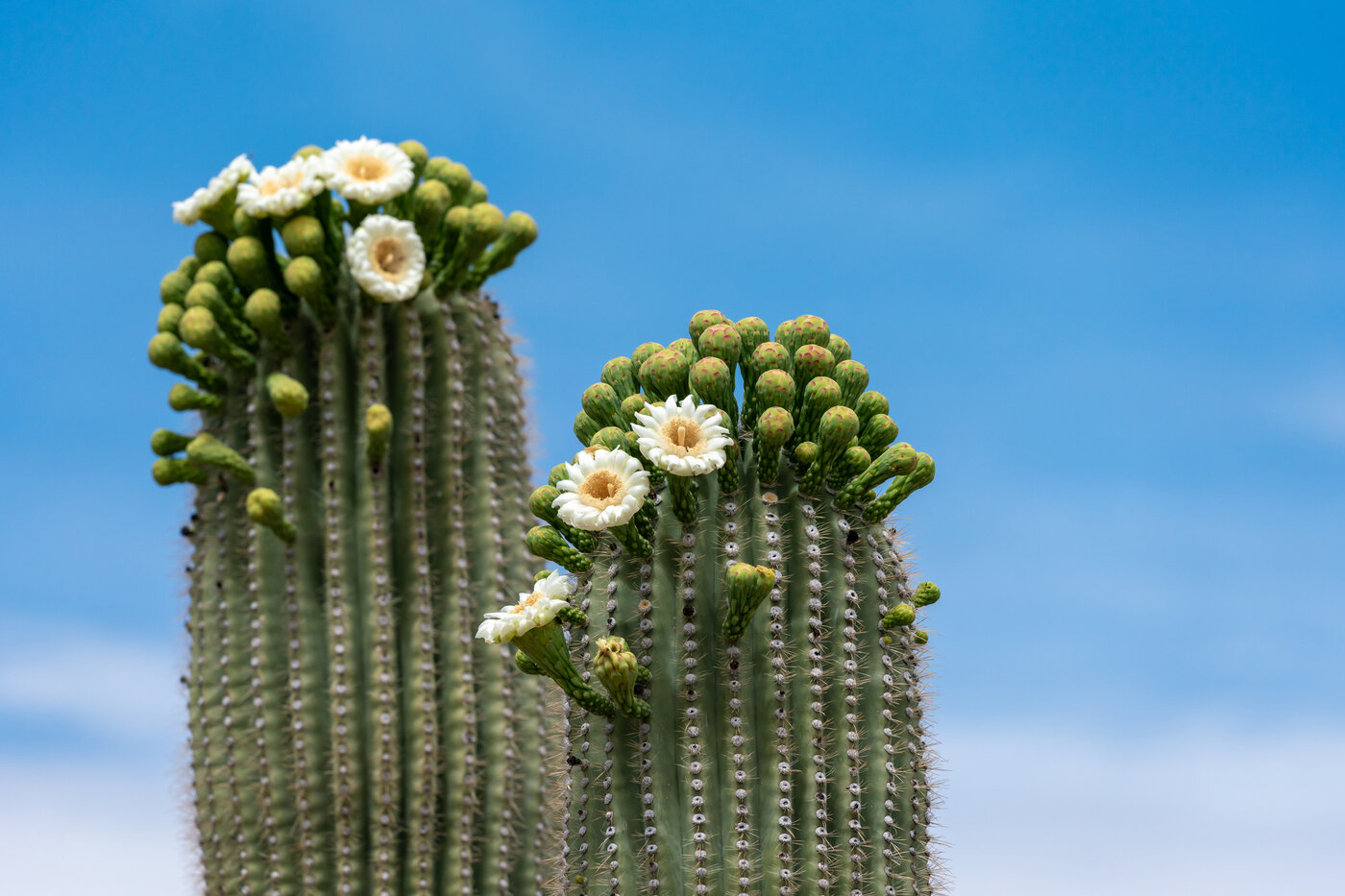Spiderwort, sneezeweed, and smartweed all have one thing in common: they are all flowers that start with an S! This list has common flowers like Solomon’s seal and sunflower as well as culinary plants like sweet peas. OK, without further ado, here’s our list of flowers that start with S.
List of Flowers That Start With S
- Sage (Salvia officinalis)
- Sand phlox (Phlox bifida)
- Scabious (Scabiosa caucasica)
- Skullcap (Scutellaria incana)
- Sea holly (Eryngium planum)
- Sea lavender (Limonium platyphyllum)
- Sea thrift (Armeria maritima)
- Sempervivum spp. (Hens and chicks)
- Serbian bellflower (Campanula poscharskyana)
- Shasta daisy (Leucanthemum x superbum)
- Siberian bugloss (Brunnera macrophylla)
- Siberian iris (Iris sibirica)
- Silver torch cactus (Cleistocactus strausii)
- Smartweed (Persicaria spp.)
- Snapdragon (Antirrhinum spp.)
- Sneezeweed (Helenium autumnale)
- Snow-in-summer (Cerastium tomentosum)
- Soapwort (Saponaria officinalis)
- Solanum (Solanum seaforthianum)
- Solomon’s seal (Polygonatum biflorum)
- Spiderwort (Tradescantia spp.)
- Spider flower (Cleome spp.)
- Spigelia marilandica (Indian pink)
- Spiranthes odorata (Ladies’ tresses)
- Spotted dead nettle (Lamium maculatum)
- Spurge (Euphorbia spp.)
- Stoke’s aster (Stokesia laevis)
- Stylophorum diphyllum (Wood poppy)
- ‘Sungold’ sunflower (Helianthus annuus)
- Sweet pea (Lathyrus odoratus)
- Symphyotrichum spp. (Aster)
1. Sage (Salvia officianalis)
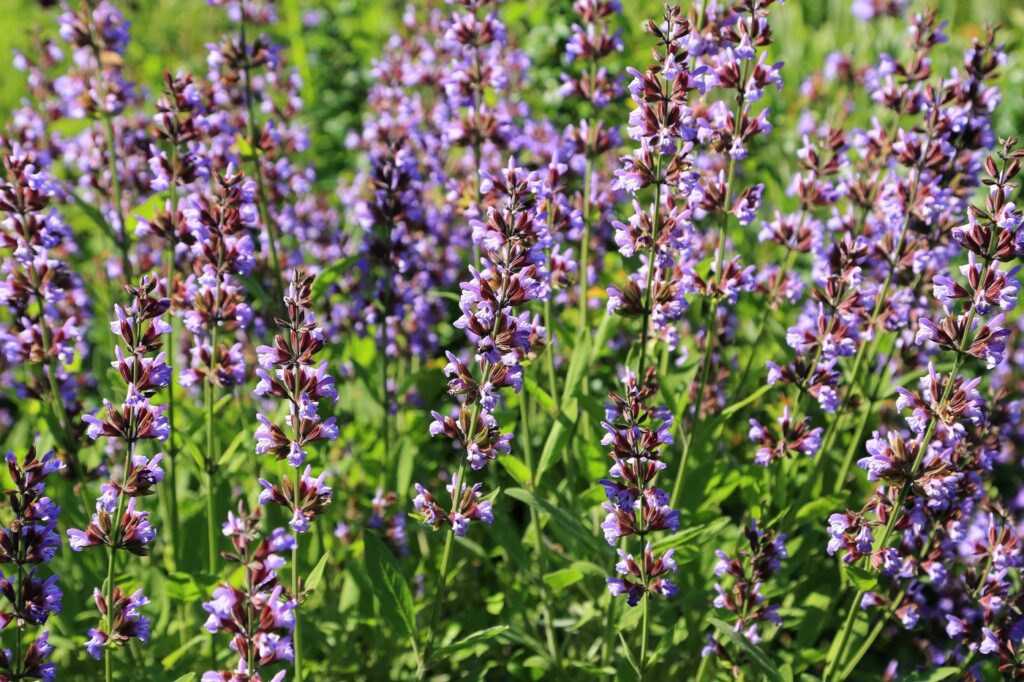
Sage is a pollinator-friendly plant that is often used as a culinary herb. Native to the Mediterranean and northern Africa, it is lauded for its healing properties. In fact, its root salveo is Latin for “healing.”
- Type: Herbaceous perennial
- Water: Average
- Bloom color: Purple
- Hardiness zone(s): 4 to 8
- Bloom time: Summer
- Mature height (feet): 1 to 4
- Exposure: Full sun
- Uses: Borders and meadows
2. Sand phlox (Phlox bifida)
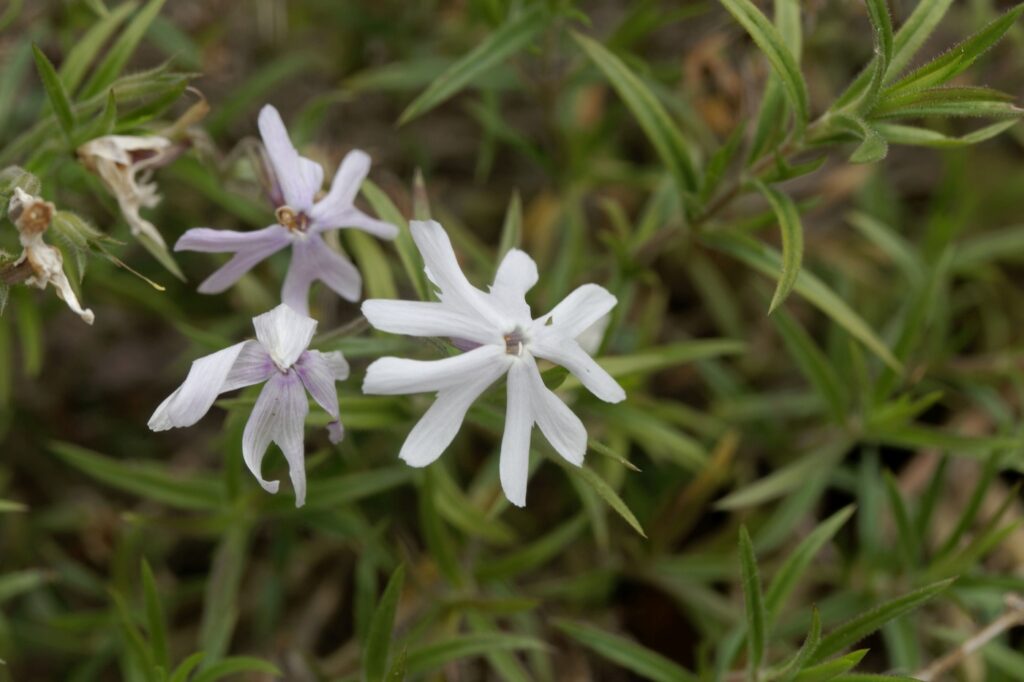
As its name indicates, sand phlox is drought-tolerant and does well in sandy soils. It blows snowflake-shaped flowers that go on to self-seed easily.
- Type: Herbaceous perennial
- Water: Dry to average
- Bloom color: Pale purple
- Hardiness zone(s): 4 to 8
- Bloom time: Spring
- Mature height (inches): 3 to 6
- Exposure: Full sun to part shade
- Uses: Borders, edges, rock gardens, and sandy parts of the garden
3. Scabious (Scabiosa caucasica)
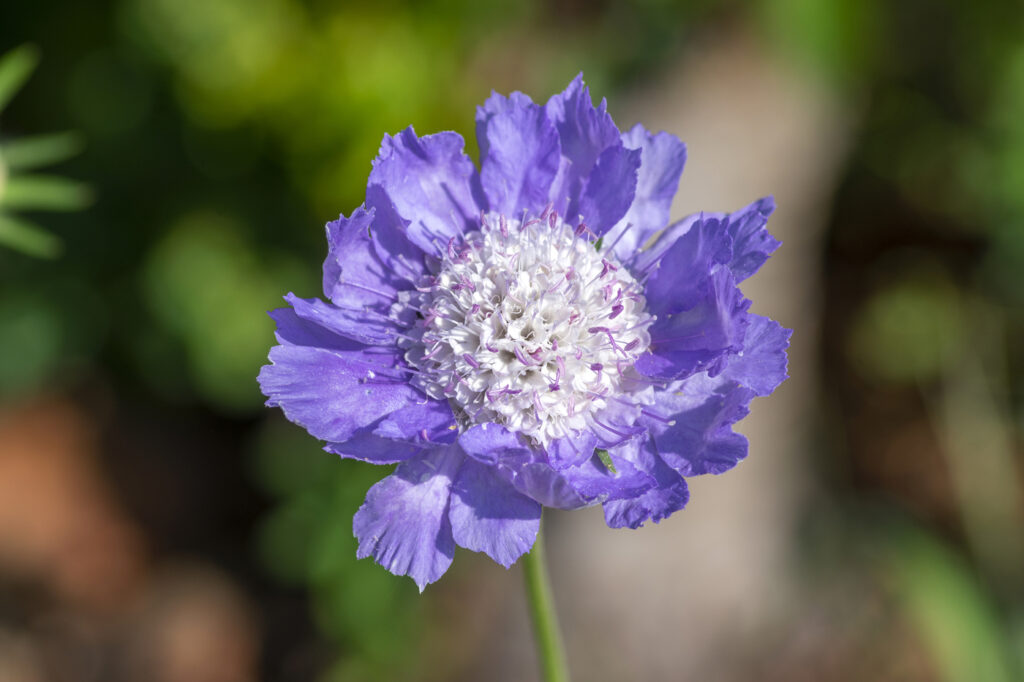
The scabious is a pollinator-friendly flower that resembles a frilly pincushion. With sturdy stems, it makes for a good cut flower. It’s also drought-tolerant.
- Type: Herbaceous perennial
- Water: Average
- Bloom color: Blue, pink, and white
- Hardiness zone(s): 3 to 7
- Bloom time: Early summer
- Mature height (inches): 8 to 24
- Exposure: Full sun
- Uses: Borders
4. Skullcap (Scutellaria incana)
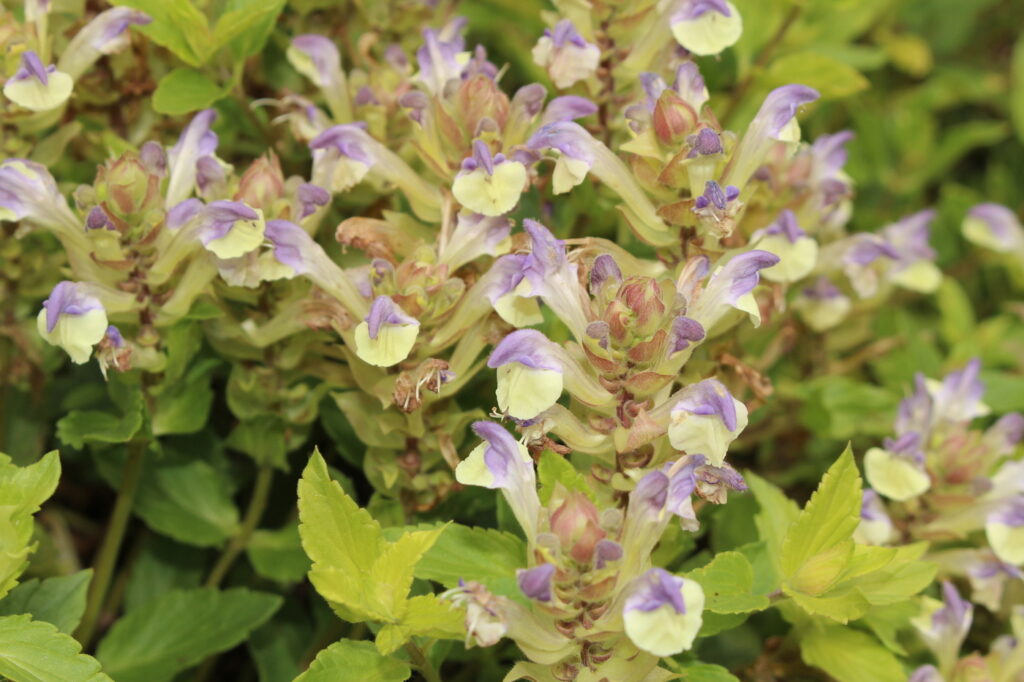
The skullcap is a drought-tolerant wildflower that attracts pollinators. The name comes from its resemblance to a helmet, or skullcap; definitely one of the more unique flowers starting with S.
- Type: Herbaceous perennial
- Water: Average
- Bloom color: Purple and blue
- Hardiness zone(s): 5 to 8
- Bloom time: Summer
- Mature height (feet): 2 to 3
- Exposure: Full sun to part shade
- Uses: Borders
5. Sea holly (Eryngium planum)
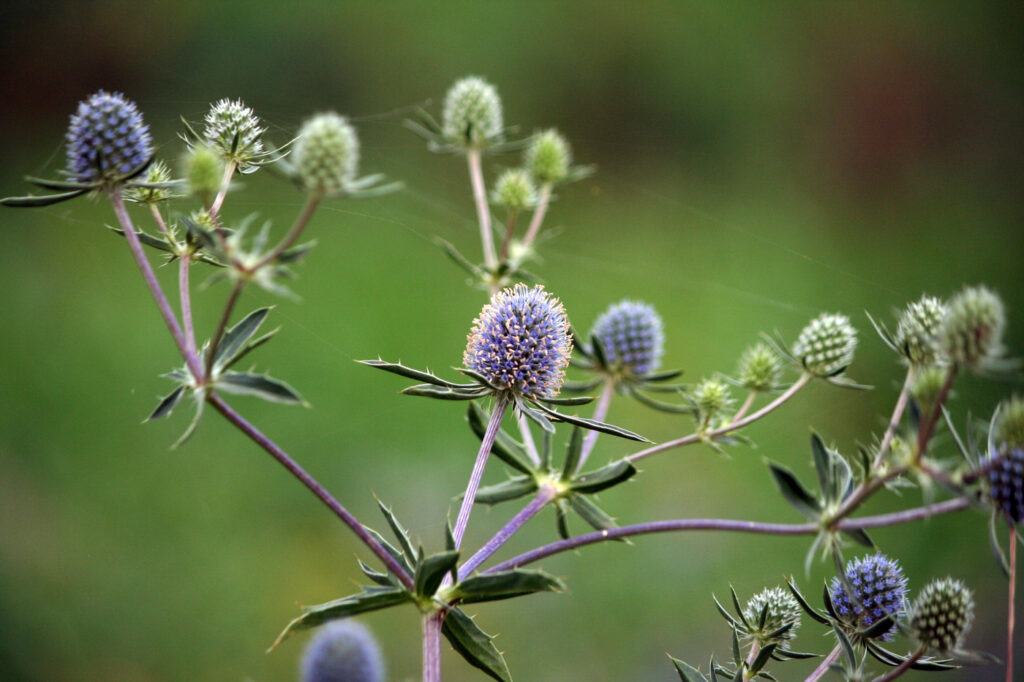
This iconic plant has striking silvery-blue and spikey foliage. It’s another drought-tolerant plant that thrives in gardens close to the sea. Some species were once used to treat rattlesnake bites.
- Type: Herbaceous perennial
- Water: Average in well-draining soil
- Bloom color: Blue/violet
- Hardiness zone(s): 5 to 9
- Bloom time: Summer
- Mature Height (feet): 1½ to 3
- Exposure: Full sun
- Uses: Borders and sandy spots in the garden
6. Sea lavender (Limonium platyphyllum)
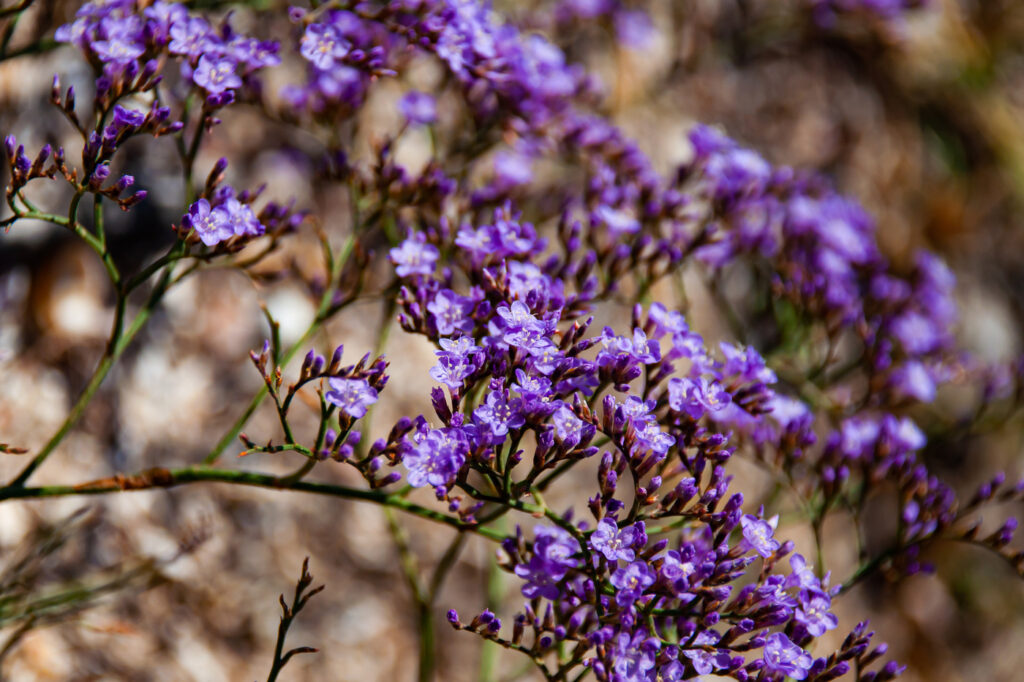
Native to southeastern and central Europe, the sea lavender makes for an excellent cut flower. It’s often used in dried flower arrangements.
- Type: Herbaceous perennial
- Water: Average
- Bloom color: Lavender blue
- Hardiness Zone(s): 3 to 9
- Bloom Time: Early summer
- Mature Height (feet): 2 to 3
- Exposure: Full sun
- Uses: Borders, rock gardens, and sandy parts of the garden
7. Sea thrift (Armeria maritime)
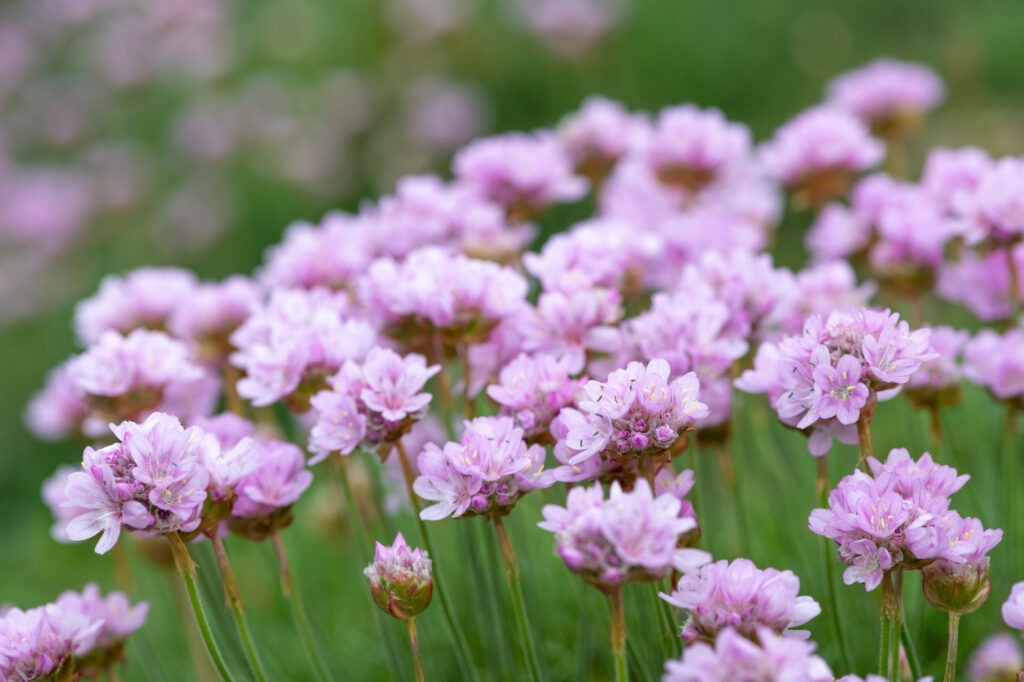
Sea thrift is native to North America and Europe. It does best in dry, well-draining soils and is drought-tolerant. Its blooms are made up of specialized leaves called bracts with small flowers in the middle.
- Type: Herbaceous perennial
- Water: Well-drained soil, let the soil dry out between waterings
- Bloom color: Pink
- Hardiness zone(s): 4 to 8
- Bloom time: Early summer
- Mature height (inches): 6 to 12
- Exposure: Full sun
- Uses: Border edges, rock gardens, and sandy spots in the garden
8. Sempervivum spp. (Hens and chicks)
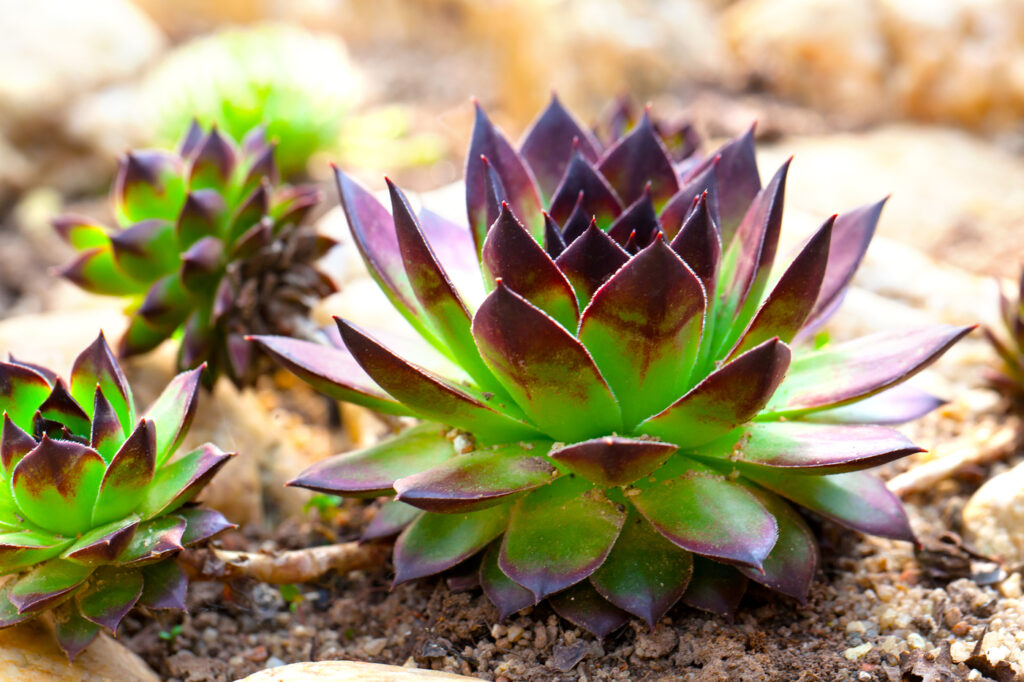
Sempervivum plants are native to the mountainous regions of southern Europe and northern Africa. They are drought-tolerant and have evergreen foliage.
- Type: Herbaceous perennial
- Water: Let the soil dry between waterings
- Bloom color: White
- Hardiness zone(s): 4 to 9
- Bloom time: Summer
- Mature height (inches): 3 to 36
- Exposure: Full sun
- Uses: Rock garden and containers
9. Serbian bellflower (Campanula poscharskyana)
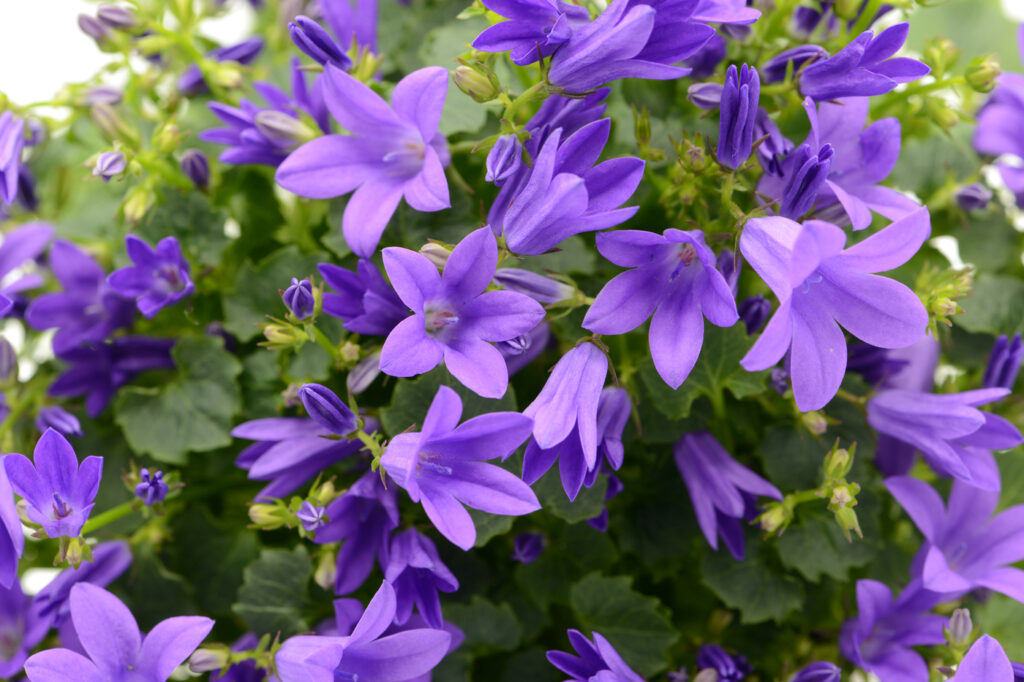
The Serbian bellflower is native to southeastern Europe. It grows in mounds and is propagated by division. This is one of the more exotic flowers that start with S.
- Type: Herbaceous perennial
- Water: Average to medium
- Bloom color: Purple
- Hardiness zone(s): 3 to 8
- Bloom time: Late Spring
- Mature height (inches): 6 to 12
- Exposure: Full sun to part shade
- Uses: Borders and edging
10. Shasta daisy (Leucanthemum x superbum)
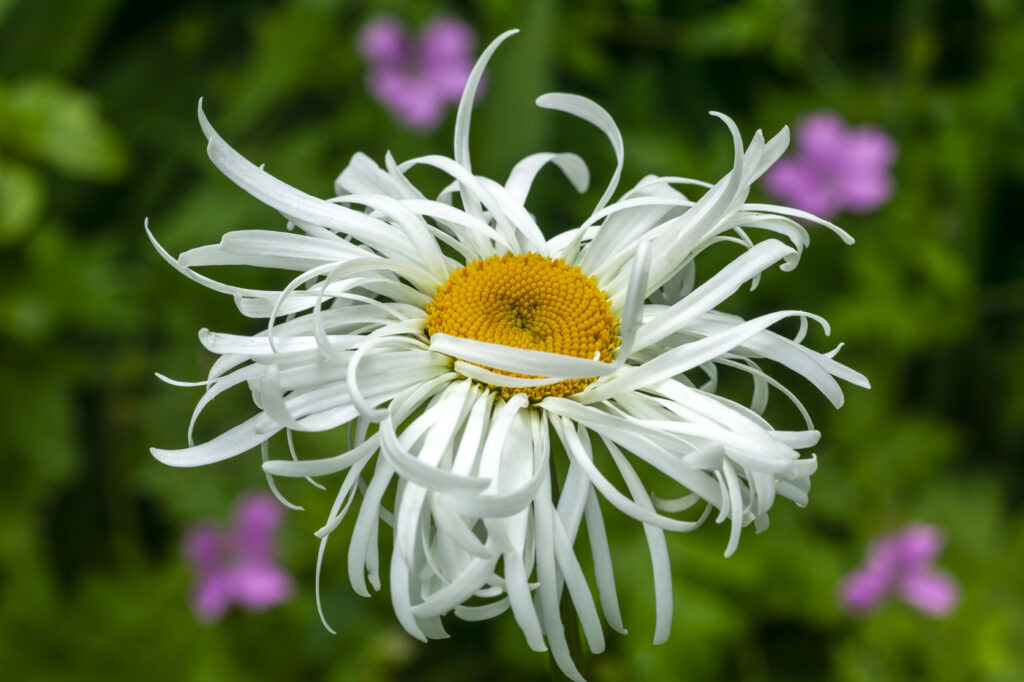
Few flowers are as recognizable as the shasta daisy. These make excellent cut flowers and can be used in cooking and baking.
- Type: Herbaceous perennial
- Water: Keep soil moist
- Bloom color: White with yellow centers
- Hardiness zone(s): 5 to 9
- Bloom time: Summer
- Mature height (inches): 1⅓ to 3
- Exposure: Full sun
- Uses: Borders, containers, and children’s gardens
11. Siberian bugloss (Brunnera macrophylla)
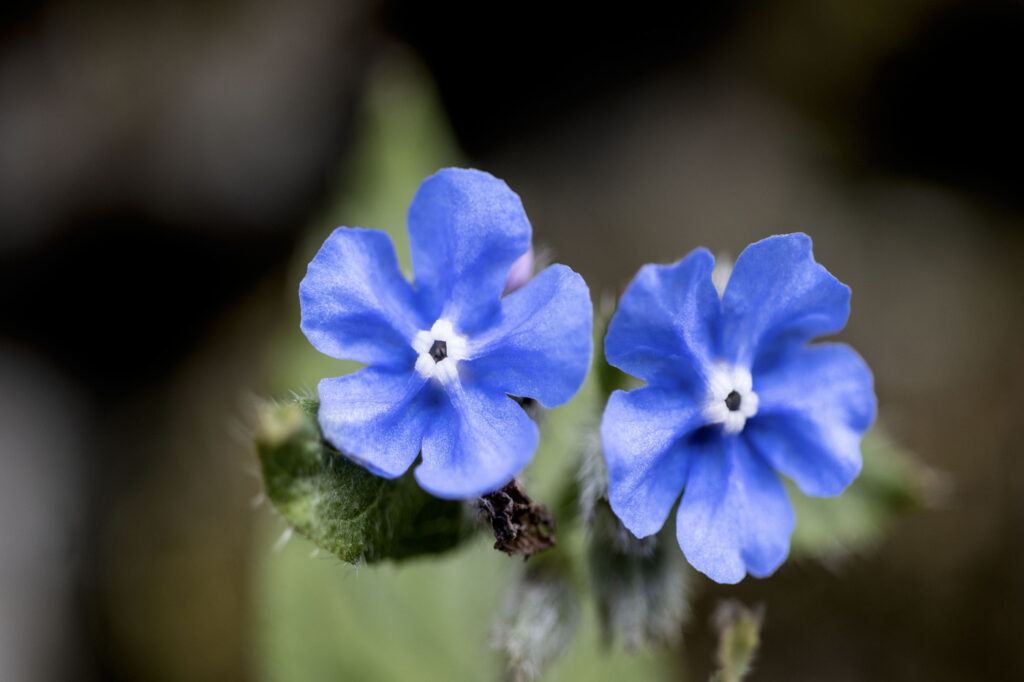
The Siberian bugloss is native to Turkey and prefers cooler climates. This plant has dainty, blue flowers and is spread by rhizomes.
- Type: Herbaceous perennial
- Water: Moist
- Bloom color: Blue
- Hardiness zone(s): 3 to 8
- Bloom time: Spring
- Mature height (feet): 1 to 1½
- Exposure: Part shade to shade
- Uses: Woodland edges and containers
12. Siberian iris (Iris sibirica)
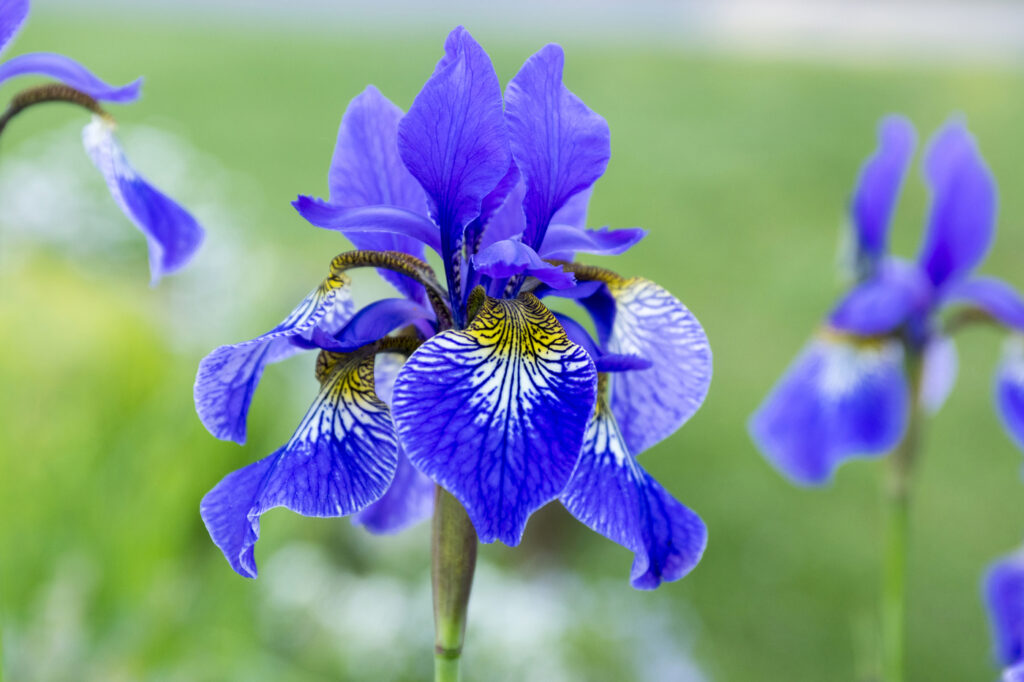
The Siberian iris has striking purple blooms and makes for an excellent cut flower. It can tolerate a range of soils and is rabbit and deer resistant.
- Type: Herbaceous perennial
- Water: Average to moist
- Bloom color: Purple
- Individual characteristics:
- Hardiness zone(s): 3 to 8
- Bloom time: Spring
- Mature height (feet): 2 to 3
- Exposure: Full sun to part shade
- Uses: Borders, backgrounds, water’s edge, and rain gardens
13. Silver torch cactus (Cleistocactus strausii)
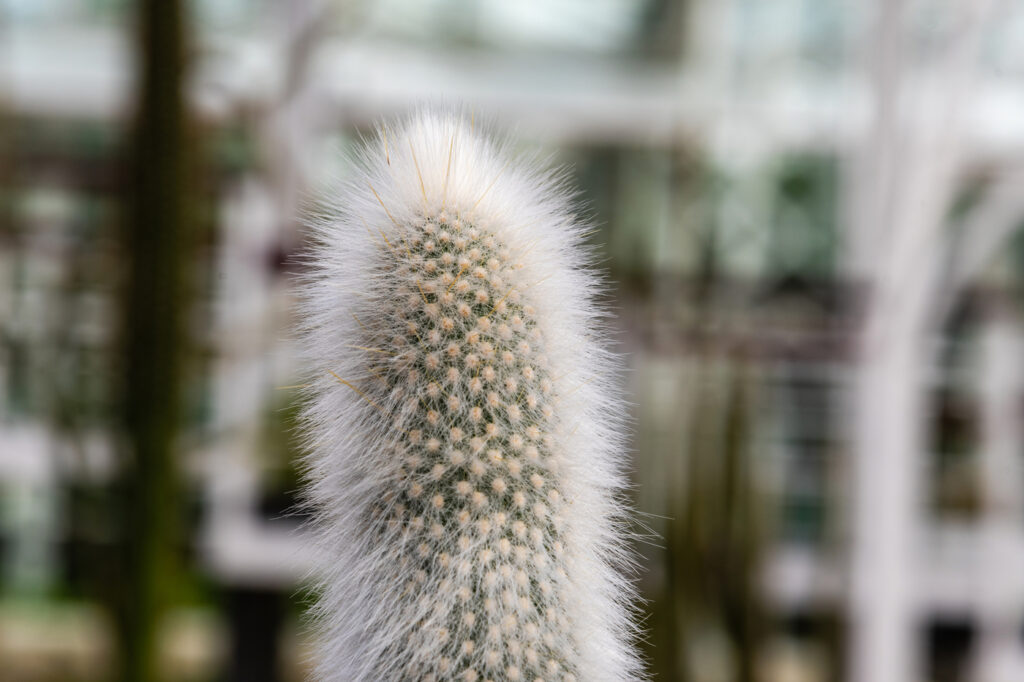
For being a desert plant, the silver torch cactus does not tolerate excessive heat well. Occasional shade from the direct summer sun is recommended to prevent scorching.
- Type: Succulent cactus
- Water: Let the soil dry out between waterings and seldom water in winter
- Bloom color: Red
- Hardiness zone(s): 9 to 10
- Bloom time: Summer
- Mature height (feet): 8 to 10
- Exposure: Full sun
- Uses: Rock gardens and sandy parts of the garden
14. Smartweed (Persicaria spp.)
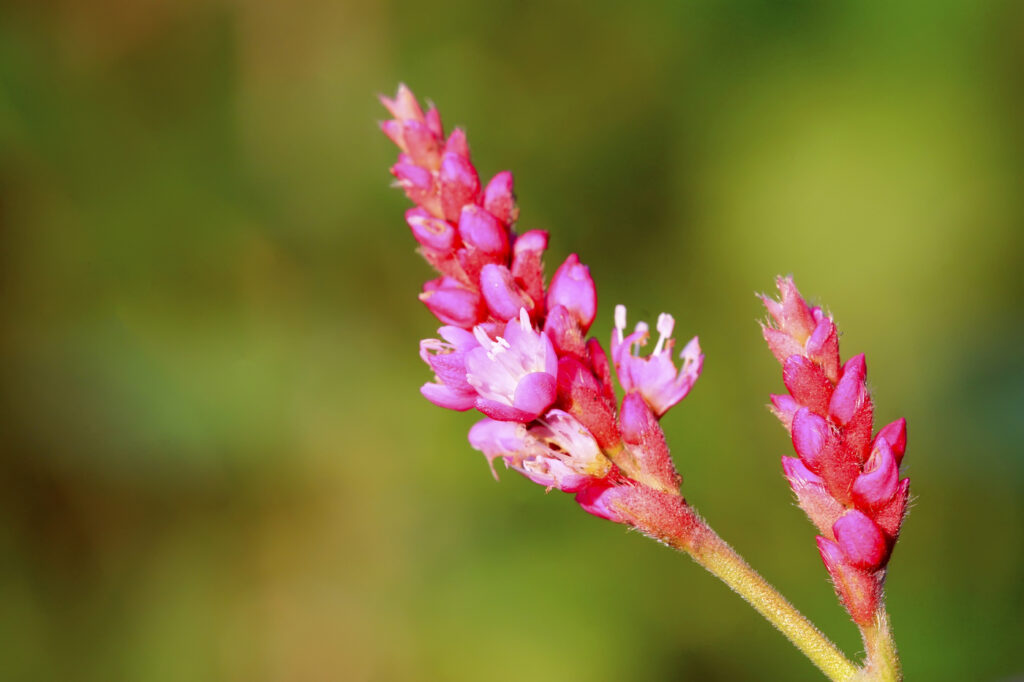
As the name implies, some species are invasive. To keep smartweed from taking over your garden, we recommend you plant it in containers.
- Type: Herbaceous perennials
- Water: Keep soil moist
- Bloom color: Red, rose, pink, white
- Hardiness zone(s): 4 to 8
- Bloom time: Summer
- Mature height (feet): 1½ to 4
- Exposure: Full sun
- Uses: Borders and containers
15. Snapdragon (Antirrhinum spp.)
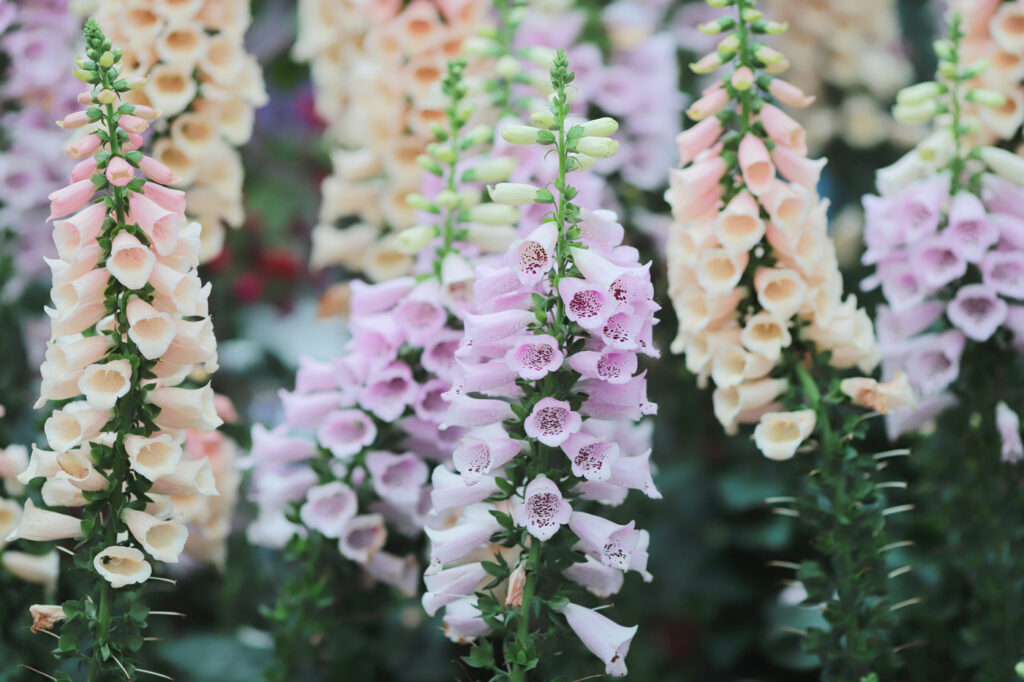
Snapdragons attract both butterflies and hummingbirds. They are popular long-blooming flowers that are easy to grow. Some species have seedheads that look like tiny skulls.
- Type: Herbaceous perennial or annual
- Water: Average
- Bloom color: White, yellow, pink, red, orange, purple, and bi-color
- Hardiness zone(s): 8 to 10
- Bloom time: Spring until fall
- Mature height (feet): 1 to 3
- Exposure: Full sun to part shade
- Uses: Containers, hanging baskets, borders, and edgings
16. Sneezeweed (Helenium autumnale)
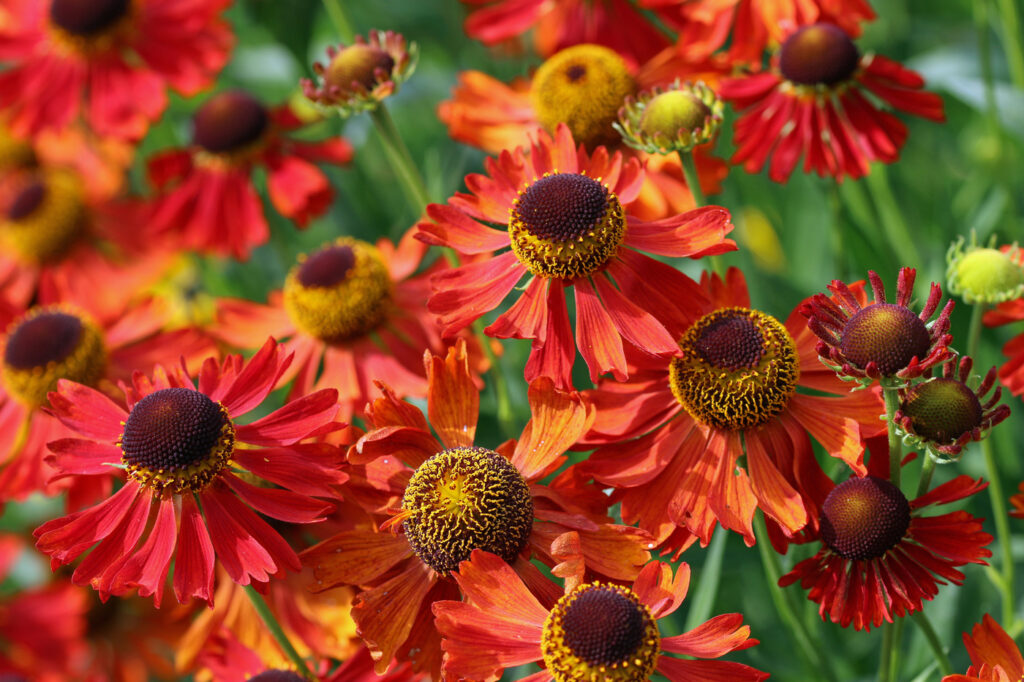
This well-loved, showy flower does best in moist soils. It attracts pollinators and other beneficial insects.
- Type: Herbaceous perennial
- Water: Average
- Bloom color: Yellow, orange, and red
- Hardiness zone(s): 4 to 9
- Bloom time: Summer to fall
- Mature height (feet): 1½ to 5
- Exposure: Full sun
- Uses: Borders and meadows
17. Snow-in-summer (Cerastium tomentosum)
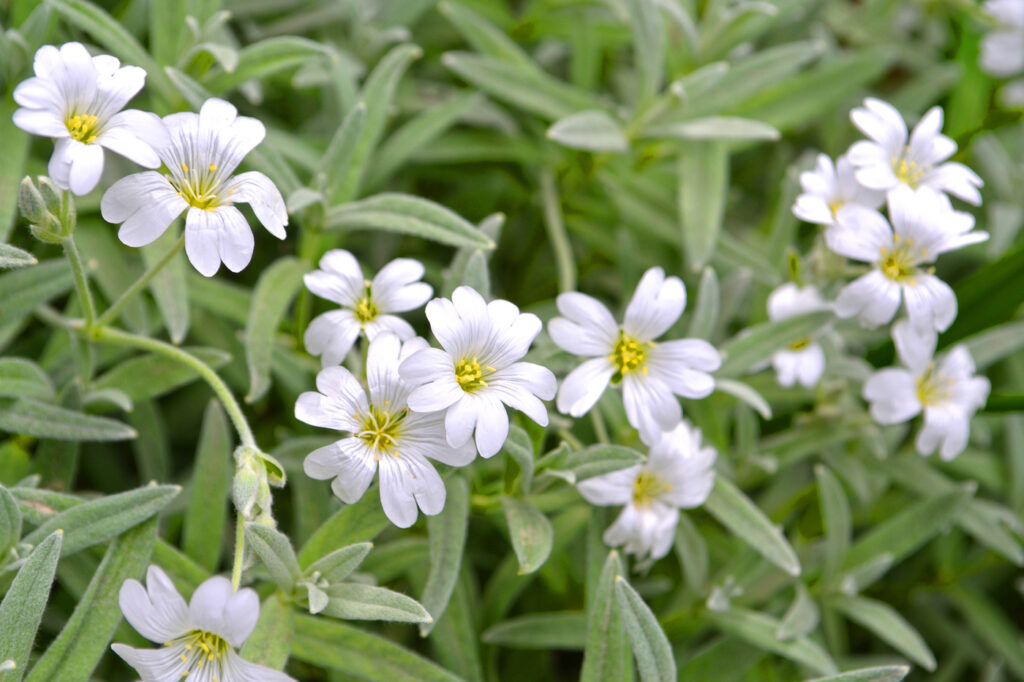
Snow-in-summer is one of the flowers starting with S with high drought tolerance and a resistance to cooler climates. It has a short-lived groundcover with silvery foliage and bright white blooms.
- Type: Herbaceous perennial
- Water: Average in well-drained soil
- Bloom color: White
- Hardiness zone(s): 3 to 7
- Bloom time: Late spring
- Mature height (inches): 6 to 10
- Exposure: Full sun
- Uses: Border edges, rock gardens, groundcover, and sandy spots in the garden
18. Soapwort (Saponaria officinalis)
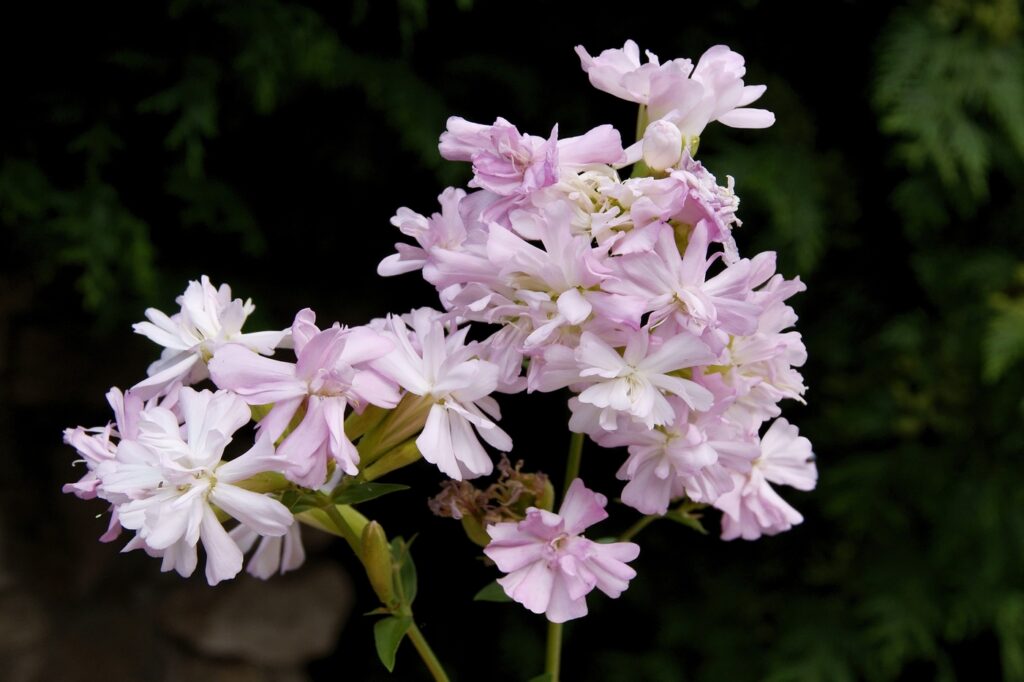
This European native has fragrant blooms and is drought-tolerant. It’s commonly found on roadsides in the US. It was used to make soap during colonial times, hence the name ‘soapwort.’
- Type: Herbaceous perennial
- Water: Average
- Bloom color: Pink
- Hardiness zone(s): 3 to 8
- Bloom time: Late spring
- Mature height (inches): 3 to 24
- Exposure: Full sun
- Uses: Rock gardens, edging, and groundcover
19. Solanum (Solanum seaforthianum)
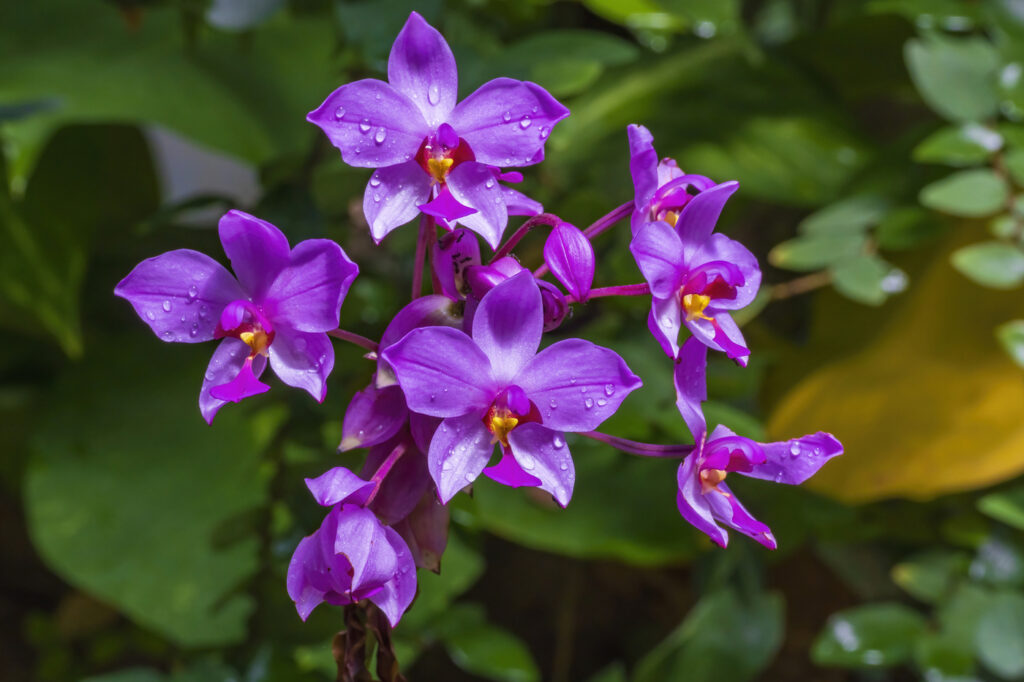
Solanum has showy, fragrant blooms, making it one of the most attractive flowers that start with S. It attracts beneficial insects as well as birds.
- Type: Annual vine
- Water: Average
- Bloom color: Purple
- Hardiness zone(s): 11 to 12
- Bloom time: Summer
- Mature height (feet): 15 to 20
- Exposure: Full sun to part shade
- Uses: Trellises, lattices, arches, and pagodas
20. Solomon’s seal (Polygonatum biflorum)
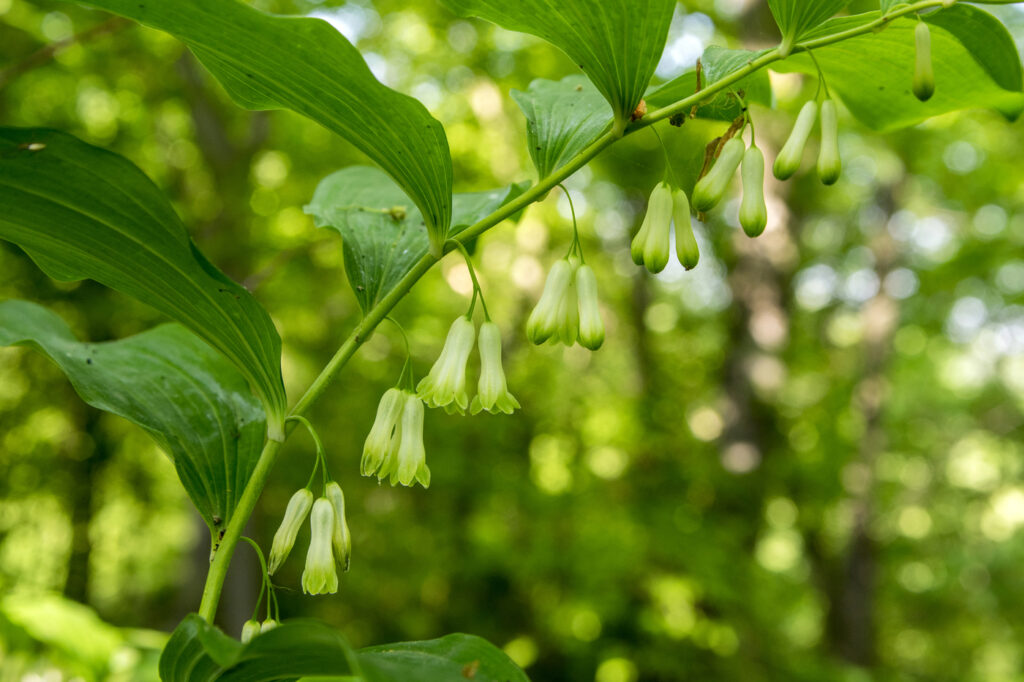
Solomon’s seal is a popular plant that has delicate blooms. It’s often grown for its architectural, alternating leaf structure.
- Type: Herbaceous perennial
- Water: Average
- Bloom color: White
- Hardiness zone(s): 3 to 8
- Bloom time: Spring
- Mature height (feet): 1 to 3
- Exposure: Part shade to shade
- Uses: Woodlands and shaded parts of the garden
21. Spiderwort (Tradescantia spp.)
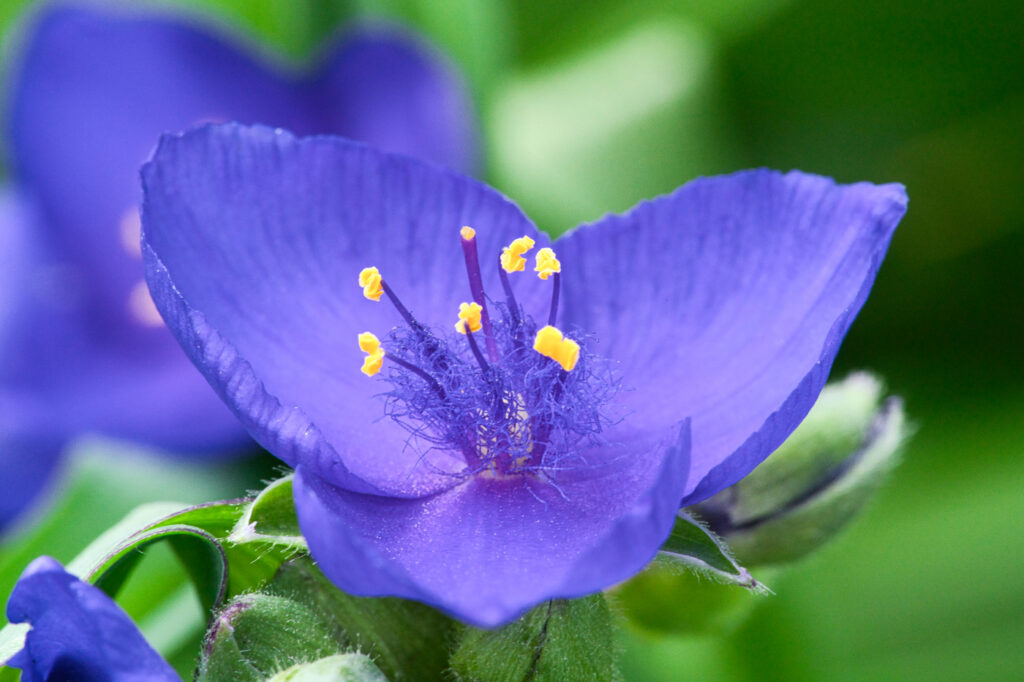
The easy-to-grow plant is native to the US. However, they may be difficult to find in nurseries as they are endangered. If you’re on the lookout for exotic flowers starting with S, keep an eye out for this flower!
- Type: Herbaceous perennial
- Water: Average
- Bloom color: Blue, purple, white, and pink
- Hardiness zone(s): 4 to 9
- Bloom time: Early summer
- Mature height (feet): 1½ to 3
- Exposure: Full sun to part shade
- Uses: Borders, meadows, and rock gardens
22. Spider flower (Cleome spp.)
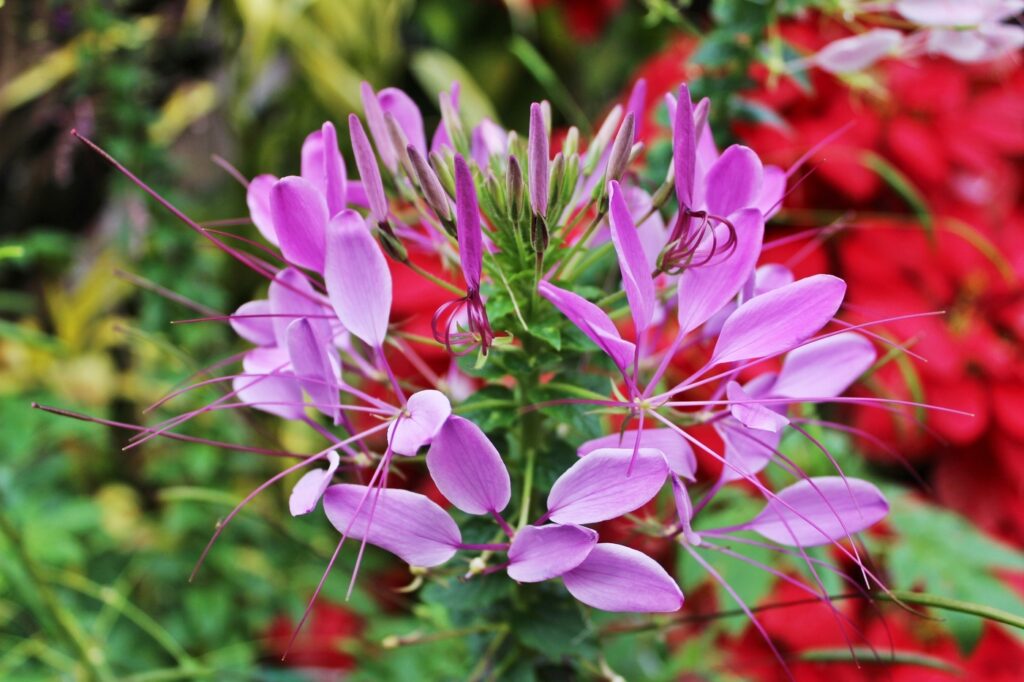
The spider flower is one of the flowers that start with S that are popular among gardeners as it’s easy to grow and pollinator-friendly. Its bold blooms also attract hummingbirds.
- Type: Herbaceous perennial or annual
- Water: Average
- Bloom color: Pink
- Hardiness zone(s): 9 to 10
- Bloom time: Summer
- Mature height (feet): 2 to 4
- Exposure: Full sun to part shade
- Uses: Woodlands
23. Spigelia marilandica (Indian Pink)
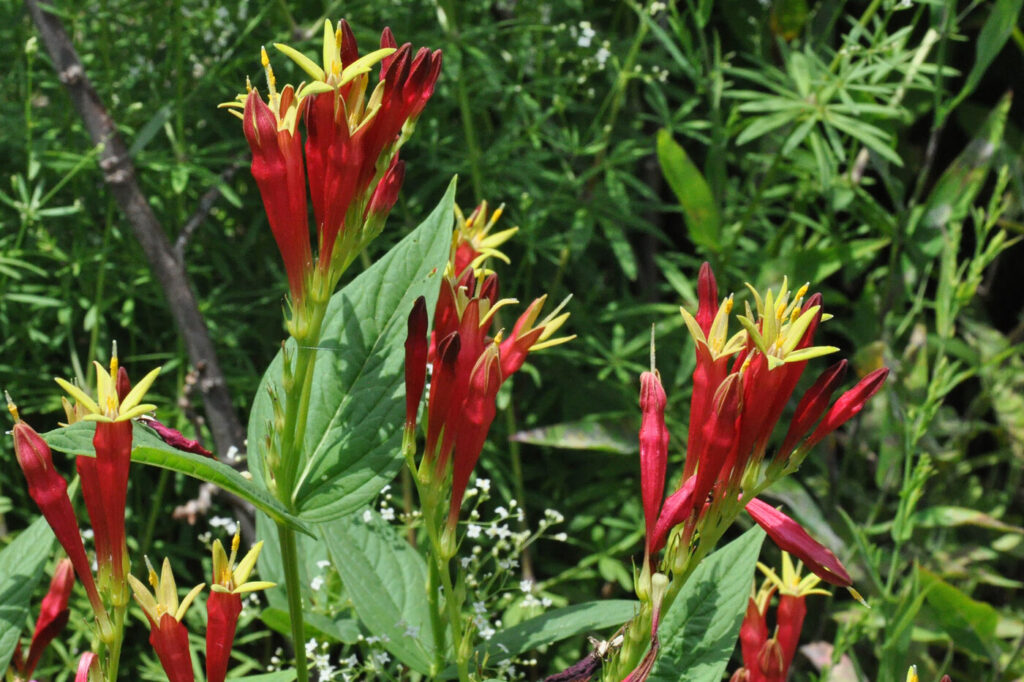
With its vibrant red blooms, this plant is pollinator-friendly and attracts hummingbirds. It has unique, trumpet-like flowers and grows alongside streams and rivers.
- Type: Herbaceous perennial
- Water: Keep soil moist
- Bloom color: Red and yellow
- Hardiness zone(s): 5 to 9
- Bloom time: Early summer
- Mature height (feet): 1 to 2
- Exposure: Full sun to part shade
- Uses: Woodlands
24. Spiranthes odorata (Ladies’ tresses)
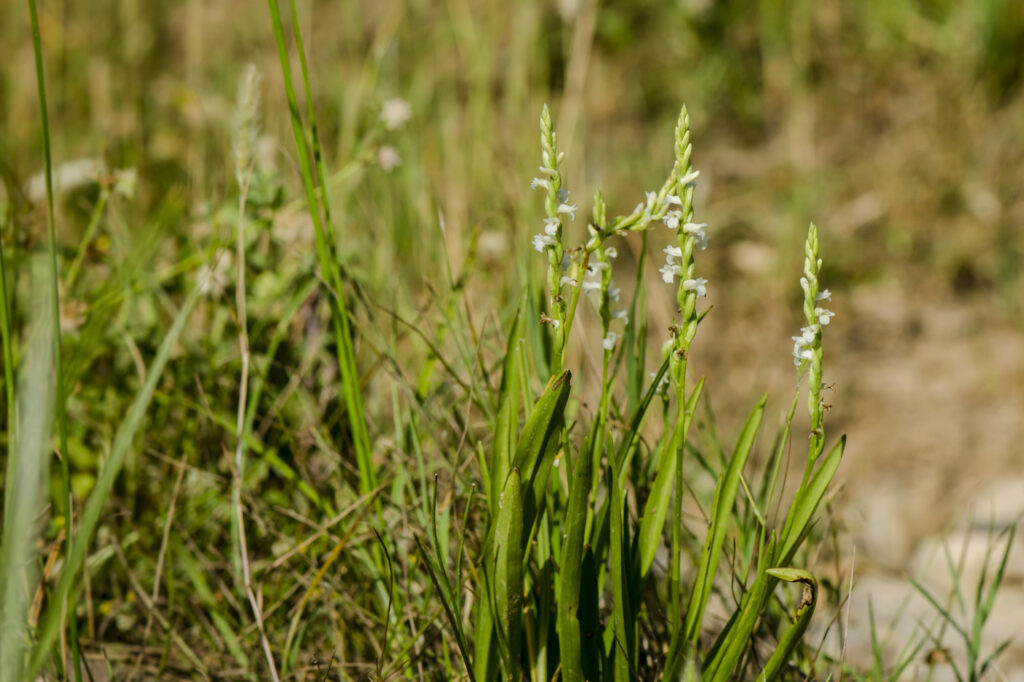
This plant is an orchid and is native to eastern North America. Its spire-like flowers that start with S are beautiful and fragrant.
- Type: Herbaceous perennial
- Water: Moist to wet
- Bloom color: White
- Hardiness zone(s): 5 to 9
- Bloom time: Late summer
- Mature height (inches): 2 to 24
- Exposure: Part shade
- Uses: Wet woodlands, bogs, and waterside
25. Spotted dead nettle (Lamium maculatum)
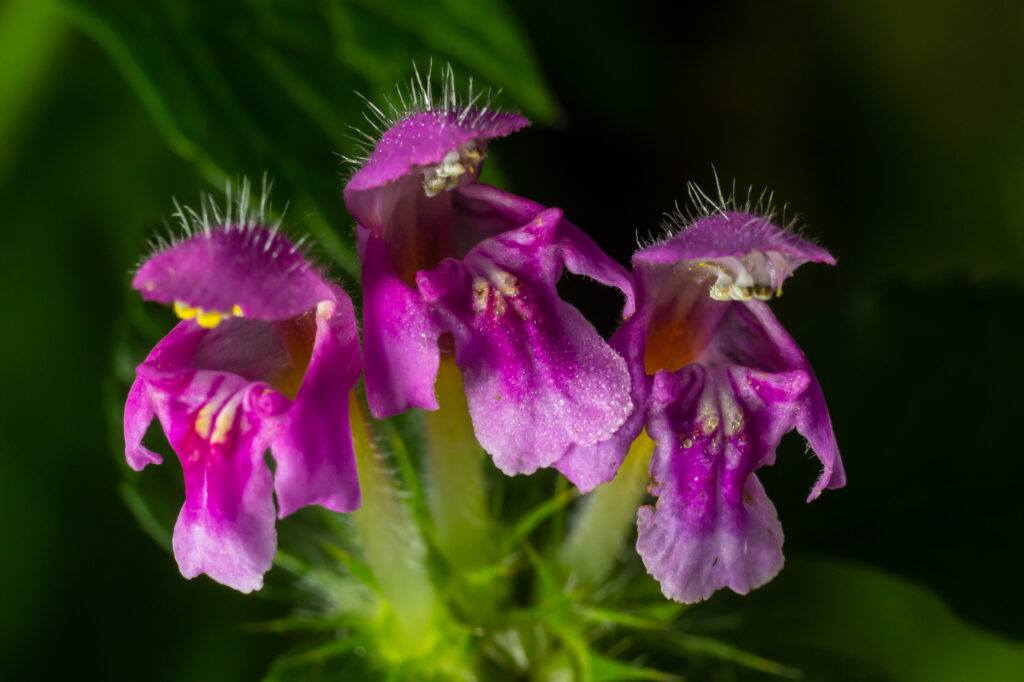
Spotted dead nettle does best in cool areas with low humidity. It has unique white and green foliage; its blooms are certainly some of the most exotic flowers that start with S!
- Type: Herbaceous perennial
- Water: Average to moist
- Bloom color: Red and pink
- Hardiness zone(s): 4 to 8
- Bloom time: Summer
- Mature height (inches): 3 to 9
- Exposure: Part shade to full shade
- Uses: Woodlands, shaded borders, and groundcover
26. Spurge (Euphorbia spp.)
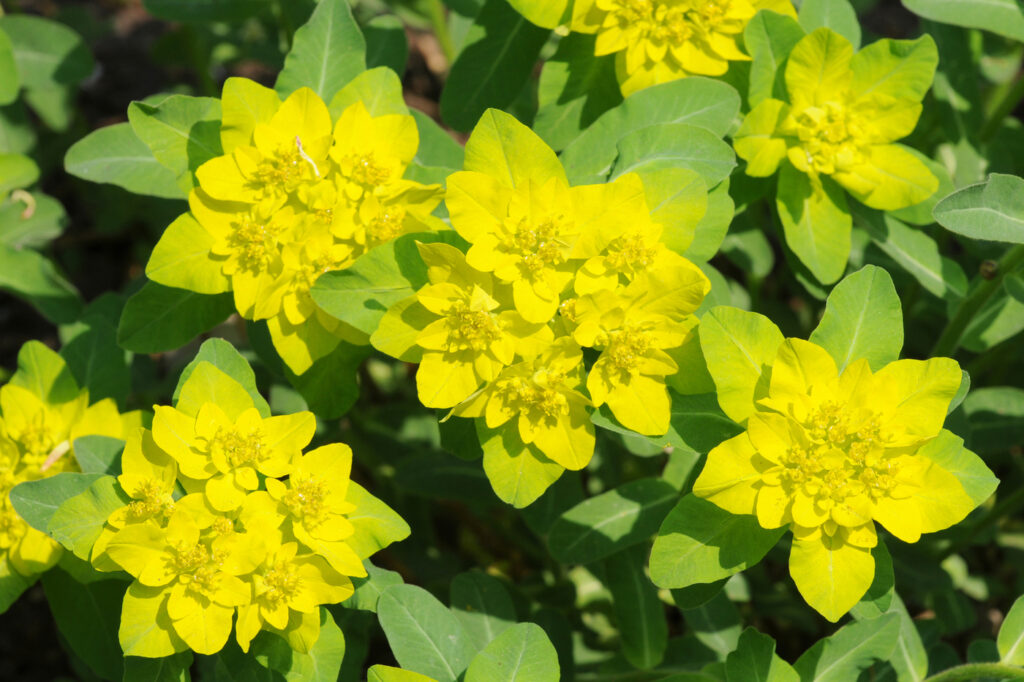
Spurge is typically grown for its striking foliage rather than its flowers. It’s a popular plant, however, some species are invasive.
- Type: Herbaceous perennial
- Water: Keep moist in well-draining soil
- Bloom color: Lime green and yellow, and red
- Hardiness zone(s): 5 to 9
- Bloom time: Spring and summer
- Mature height (feet): 1 to 2
- Exposure: Full sun to part shade
- Uses: Borders
27. Stoke’s aster (Stokesia laevis)
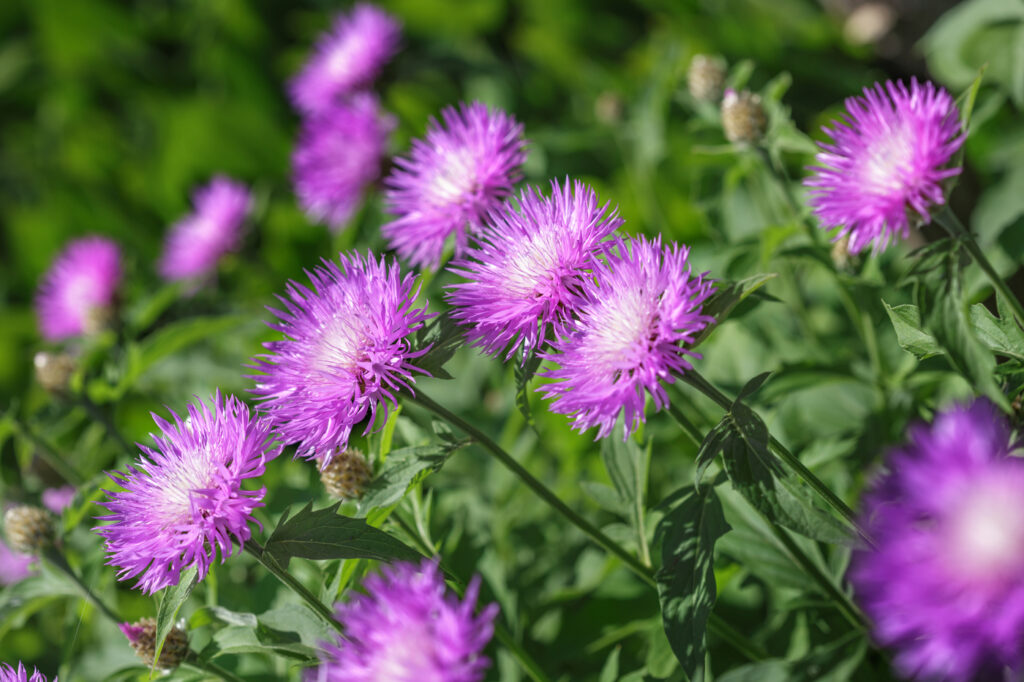
Some pink flowers that start with S are Stoke’s asters which are native to the southeastern US. The asters are pollinator-friendly and when regularly deadheaded, they are long-blooming.
- Type: Herbaceous perennial
- Water: Keep soil moist
- Bloom color: Blue and white
- Hardiness zone(s): 5 to 9
- Bloom time: Summer to Fall
- Mature height (feet): 1 to 2
- Exposure: Full sun to part shade
- Uses: Borders
28. Stylophorum diphyllum (Wood poppy)
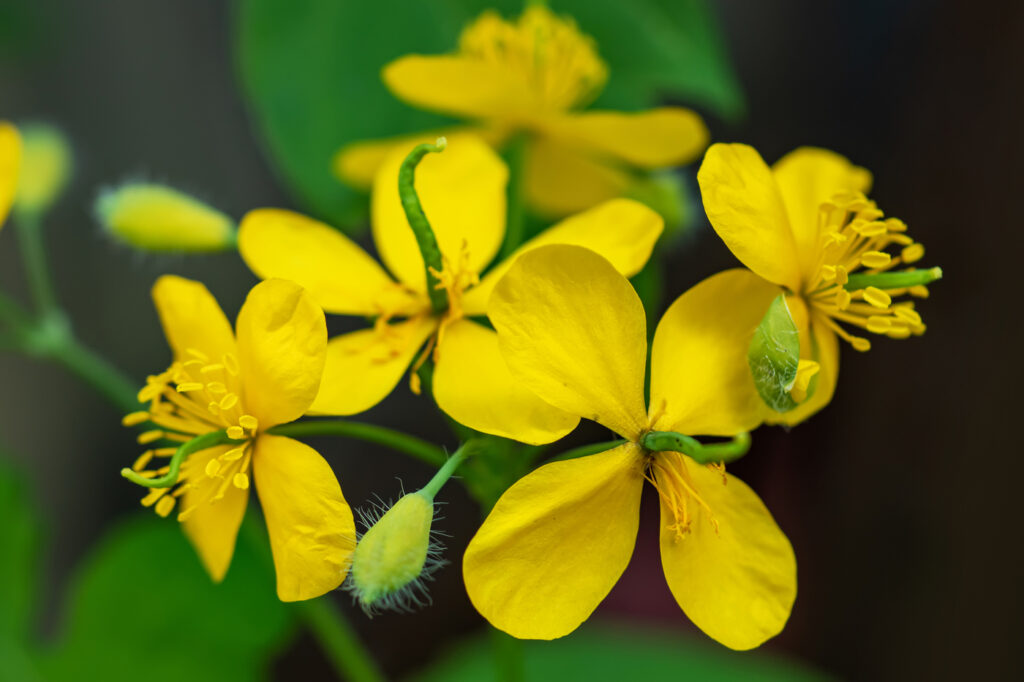
This plant is native to the eastern US and does well in woodland gardens. It self-seeds easily and has showy blooms.
- Type: Herbaceous perennial
- Water: Keep soil moist
- Bloom color: Yellow
- Hardiness zone(s): 4 to 9
- Bloom time: Spring
- Mature height (inches): 10 to 24
- Exposure: Part shade to full shade
- Uses: Shaded woodlands, and rain gardens
29. ‘Sungold’ sunflower (Helianthus annuus)
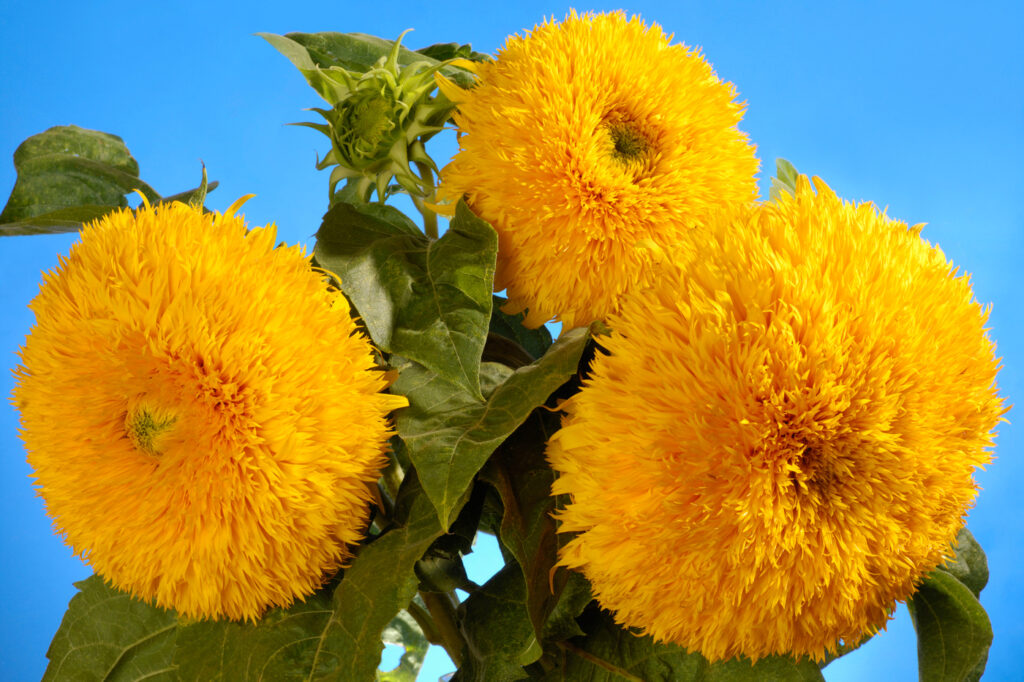
Few flowers that start with S are as recognizable as the sunflower. The flower attracts butterflies, and birds love the seeds.
- Type: Annual
- Water: Average
- Bloom color: Yellow
- Hardiness zone(s): 2 to 11
- Bloom time: Summer
- Mature height (feet): 6 to 7
- Exposure: Full sun
- Uses: Backgrounds and children’s gardens
30. Sweet pea (Lathyrus odoratus)
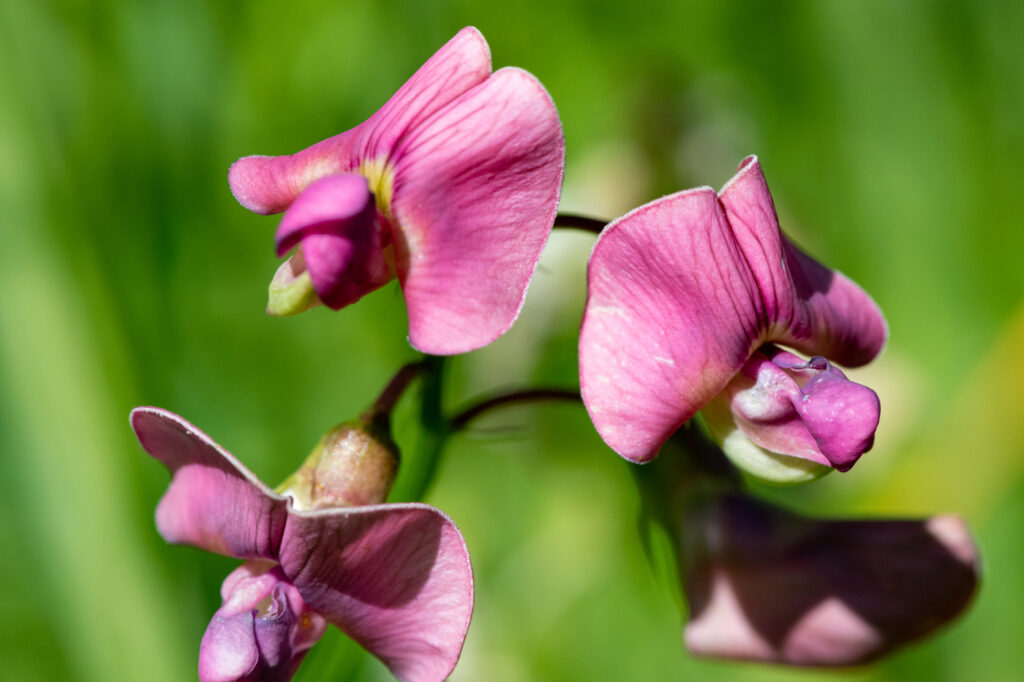
Sweet peas are grown for both their blooms and seeds. These useful flowers that start with the letter S make for a good cut flower with their seeds also being a tasty snack!
- Type: Annual
- Water: Average to moderate
- Bloom color: Red, orange, blue, purple, and pink
- Hardiness zone(s): 2 to 11
- Bloom time: Summer
- Mature height (feet): 3 to 8
- Exposure: Full sun
- Uses: Borders, lattices, fences, and containers
31. Symphyotrichum spp. (Aster)
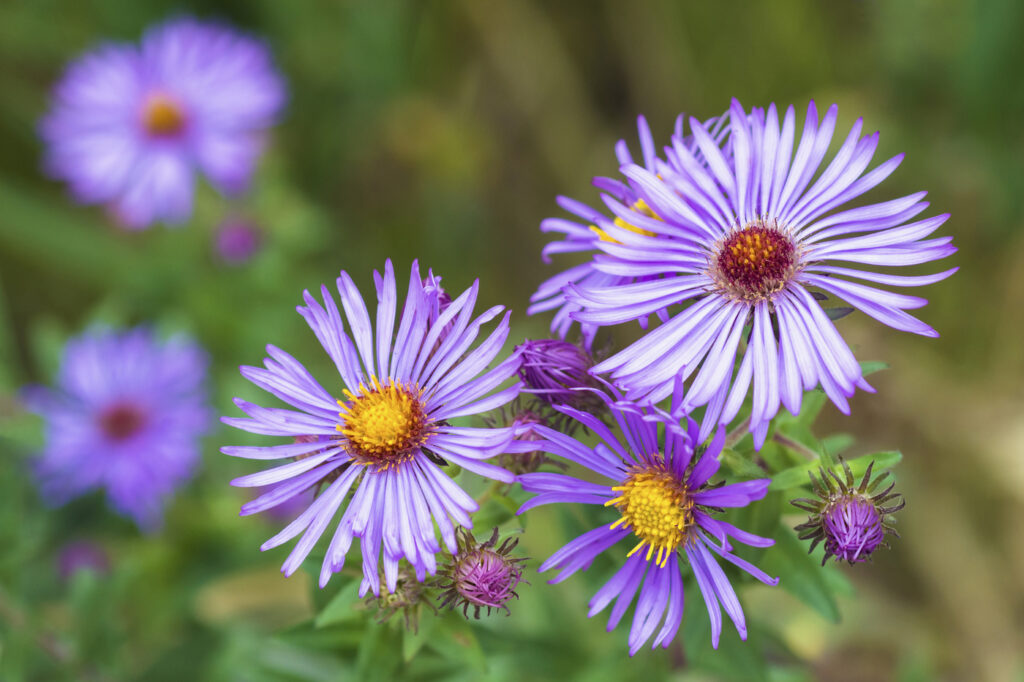
Symphyotrichum is another pollinator-friendly plant that’s drought tolerant. They are native to northeastern and central US.
- Type: Herbaceous perennial
- Water: Let the soil dry between waterings
- Bloom color: Purple, blue, and white
- Hardiness zone(s): 3 to 8
- Bloom time: Late summer to fall
- Mature height (feet): 1 to 4
- Exposure: Full sun to part shade
- Uses: Borders and meadows
Frequently Asked Questions (FAQ) About Flowers That Start With S
What are blue flowers that start with the letter S?
There are a few flowers on this list: Scabious, skullcap, sea holly, sea lavender, and solanum are all blue types of flowers that start with S.
What are the names of pink flowers that start with S?
Sanguisorba, sea thrift, spider flower, skullcap, spotted dead nettle, sweet pea, and snapdragon are all pink flowers starting with S.
How many purple flowers start with S?
The kinds of flowers that start with S and are purple include sage, sand phlox, snapdragon, skullcap, sweet peas, Siberian iris, Siberian bugloss, spiderwort, and aster.
What are some Japanese flowers that start with S?
Serbian bellflower, Siberian bugloss, and Siberian iris are three flowers starting with S that can grow in Japan.
What flowers that start with S are grown outdoors?
All of the flowers on this list can be grown outdoors in the proper growing zone. The silver torch cactus can be grown both outdoors and indoors.
Are there any exotic flowers that start with S?
There are two exotic flowers that start with S. Sea holly has an exotic appearance with its blue, spikey foliage. Solanum has an exotic appearance because it’s a rare vine that has purple flowers.
Image credit: Depositphotos & Flickr
